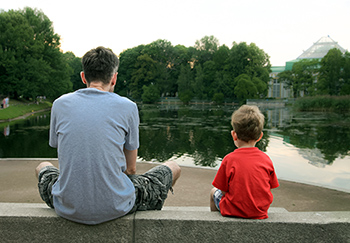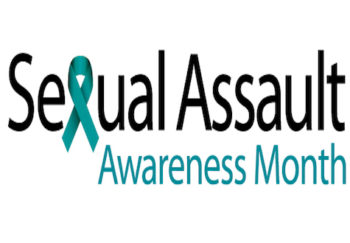
Child sexual abuse. Whether we like to think about it or not, it happens, and way more often than you think. Globally, a range of 7-36 percent of women and 3-29 percent of men experience sexual abuse in childhood. It also happens at the hands of people you might least expect. Most child sexual abuse is perpetrated by adults or older children who know the child or family. This could be a relative, babysitter, coach, teacher or family friend.
For Sexual Assault Awareness Month, we spoke with Laura Shaffer, PhD, pediatric psychologist with the UVA Health Children’s Hospital, to get some practical tips on what parents can do. You can’t protect the kids you love from every threat. But you can teach skills that empower them to protect themselves, establish boundaries and act with assertiveness. You can also help them understand that they can come to you with anything.
Healthy Body Boundaries
The main lesson to give kids? “Your body is your body,” Shaffer says. She encourages parents to speak with children from an early age about physical boundaries and the privacy of body parts. “This is your body, and it’s not ok for anyone to ask you to do certain things or to do things to you that make you uncomfortable.”
Talking to very young kids about their bodies can prove challenging. “You want to strike a balance between teaching that certain body parts are private but not so private that you can’t talk about them,” Shaffer says. She suggests teaching children the names of the genitals just as you do other body parts. This helps keep channels of communication about the body open between parents and kids.
Another challenge, of course, arises from the fact that we try to teach kids, in general, to comply with adults and follow their rules. And there’s plenty of times we do things to children they don’t want, like giving them flu shots, for instance. So it’s important to stress the distinction.
“This is the one area where we don’t want them to be compliant,” Shaffer says. “So you need to explain how we want them to follow directions and be respectful, but when it comes to their bodies and unwanted touch or violations of privacy, the rules are different. It’s OK to say no and tell somebody.” And you want to help them know the difference between good secrets (like birthday surprises) and bad secrets (anything that makes them feel unsafe or uncomfortable).
Shaffer encourages parents to continue promoting this message about boundaries throughout your child’s life, though how you do that — the language you use — will change as they age.
Why Don’t Children Tell?
About 60 percent of children who are sexually abused do not disclose it. Children often feel powerless, afraid of consequences and of not being believed if they disclose sexual abuse, which prevents them from telling parents about sexual abuse.
Assertiveness: No Means No
A critical aspect of sexual abuse prevention is raising assertive, confident kids who stand up for themselves.
Shaffer encourages parents to look for everyday opportunities. Siblings, for instance, provide an abundance of chances to help learn the skills of communicating boundaries. Parents can help kids establish privacy and personal space when they change clothes or use the bathroom.
“When you see them doing it not quite right, step in and give them guidance,” Shaffer suggests. Modeling these skills within the family relationships, taking advantage of opportunities for kids to practice them, gives children a sense of accomplishment and empowerment.
Assertiveness Training
Find real-life situations that push your child outside of the comfort zone. “Make your daughter order for the whole family at a restaurant, and support her,” Shaffer suggests. “Have your son count change at the store, and speak up if something adds up wrong. Get your kids to speak up and step up. You might have to push them a little bit, but really praise them when they do it. Coach them through it if they’re really shy and need help knowing what to say and how to do it.” Also encourage them to ask for help or address conflict themselves, when appropriate, instead of relying on you to do it for them.
Create an Open Relationship
Want to protect your child? Establish and maintain an open, trusting relationship so that your child feels comfortable coming to you with anything, including uncomfortable topics like the threat of or occurrence of abuse. The American Academy of Pediatrics recommends teaching children “early and often that there are no secrets between children and their parents, and that they should feel comfortable talking with their parents about anything – good or bad, fun or sad, easy or difficult.”
This may seem easier said than done. Shaffer breaks an open relationship down into two pieces.
Leave the Door Open
Shaffer suggests “Talking to your kids, asking but not pushing hard. Kids who withdraw more will clam up tighter if you really push. Ask, and let kids know you’re there.”
In other words, saying to a child, “You look sad today; do you want to talk about it?” invites conversation, instead of repeating, “What happened? What happened? What happened?” which can feel demanding and shut off conversation.
Open the door for conversation, but don’t force it; and leave the door open, so the child can choose to talk when ready.
Respond With Openness
When a child does tell you something, that’s your chance to establish trust. Reserve judgment and let your child talk.
This can feel counterintuitive. “As a parent, you’re trying to teach right from wrong,” Shaffer says. “But if you child steps out on a limb to tell you something, if you have a strong emotional reaction to it, that can shut the conversation down.”
And that’s a problem when it comes to a child disclosing abuse. “A big, angry reaction would be pretty normal and healthy,” Shaffer acknowledges. “But that might frighten the child, and they might become less forthcoming.”
So Shaffer advises parents to step away and deal with their emotions alone or with support from other adults before coming back to listen.
Practice Safe Interactions
Again, the critical aspect is everyday practice.
If You Suspect Child Sexual Abuse
What do you do if you suspect your child or any child you care about is experiencing sexual abuse?
- Call child protective services. You can call about any type of abuse, and the call can be anonymous. Find your local office or call the statewide hotline.
- If you are worried about ongoing abuse, call the police.
- Get support from the Sexual Assault Resource Agency (SARA), a local advocacy organization, which also has a hotline and other services.
- Get more prevention tools.
No matter what: If the child is in immediate danger, take action to keep them safe.
“If your kid comes to you to say they broke a window, you can say that’s not OK and you have to pay for it. But if they told you voluntarily, you also need to recognize that behavior and praise or thank them for telling you, so they keep coming back to you.”
Shaffer understands some parents may feel this approach lets kids off the hook for bad behavior. But, Shaffer says, “Being open, staying as calm as you can, being receptive and staying level-headed doesn’t mean you’re letting them get away with things.” It means you’re there for them, no matter what.
Shaffer also advises parents to “Keep your word; don’t make promises you might not be able to follow through with.” Having that trust firmly established in the relationship “sets the stage for when there’s a harder situation.”
“Having a positive relationship goes a long way,” she says. “Not being a friend but being someone the child trusts to keep them safe.”
Take An Active Role
As with all aspects of your child’s life, Shaffer advises parents to take an active role. Know about your child’s activities and the other people with whom they spend time. “Be wary of adults who offer special gifts for no particular occasion,” she says, “or who frequently seek out opportunities to be alone with children.”
Know the Signs of Possible Child Sexual Abuse
“Anytime there are changes in a child’s behavior, you want to pay attention,” Shaffer says. Take notice of:
- Mood changes
- More solitary, withdrawn behavior
- Increased irritability
- Increased nightmares or bedwetting
- A child becoming more guarded and embarrassed about his or her body
- Unexplained discomfort, redness or bleeding in the genitals
- Sudden avoidance of certain people or situations
- Sexual language or behavior that seems unusual for the child’s age
Of course, shifts in mood and behavior may reflect other stressors, too. Check in with your child, open up the lines of communications and be vigilant.


Excellent information every parent should read.